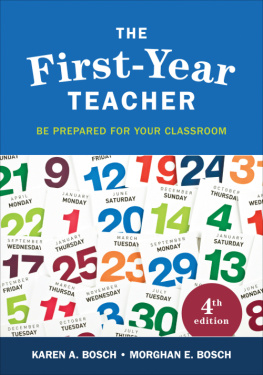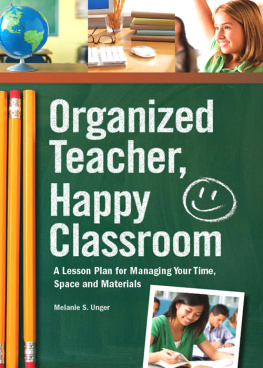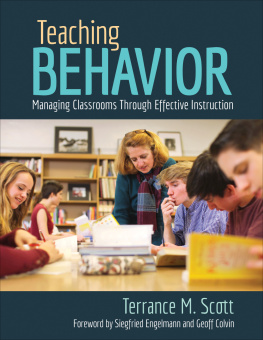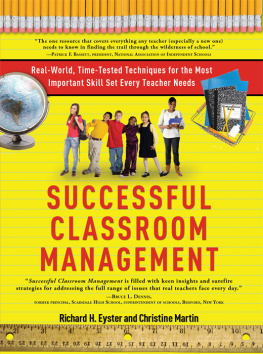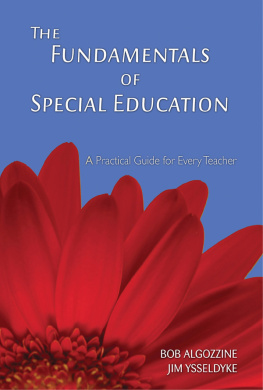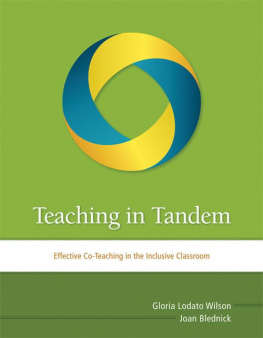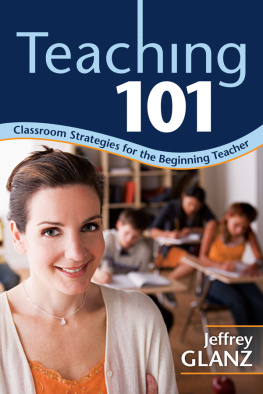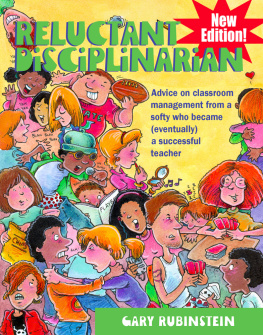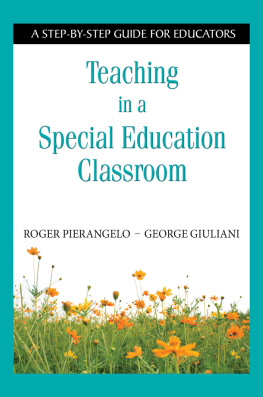


Copyright 2015 by Corwin
All rights reserved. When forms and sample documents are included, their use is authorized only by educators, local school sites, and/or noncommercial or nonprofit entities that have purchased the book. Except for that usage, no part of this book may be reproduced or utilized in any form or by any means, electronic or mechanical, including photocopying, recording, or by any information storage and retrieval system, without permission in writing from the publisher.
All trade names and trademarks recited, referenced, or reflected herein are the property of their respective owners who retain all rights thereto.
Printed in the United States of America
A catalog record of this book is available from the Library of Congress.
ISBN: 978-1-4833-1771-7
This book is printed on acid-free paper.
14 15 16 17 18 10 9 8 7 6 5 4 3 2 1

FOR INFORMATION:
Corwin
A SAGE Company
2455 Teller Road
Thousand Oaks, California 91320
(800) 233-9936
www.corwin.com
SAGE Publications Ltd.
1 Olivers Yard
55 City Road
London EC1Y 1SP
United Kingdom
SAGE Publications India Pvt. Ltd.
B 1/I 1 Mohan Cooperative Industrial Area
Mathura Road, New Delhi 110 044
India
SAGE Publications Asia-Pacific Pte. Ltd.
3 Church Street
#10-04 Samsung Hub
Singapore 049483
Acquisitions Editor: Jessica Allan
Associate Editor: Kimberly Greenberg
Editorial Assistant: Cesar Reyes
Production Editor: Melanie Birdsall
Copy Editor: Diane DiMura
Typesetter: C&M Digitals (P) Ltd.
Proofreader: Alison Syring
Indexer: Molly Hall
Cover Designer: Gail Buschman
Marketing Manager: Lisa Lysne
PREFACE
Since we have received such positive feedback from new teachers about this book and we believe the material is timeless, we have decided to revise each chapter and add new information, resources, and teacher experiences. In addition, we have added a chapter () to help the newly hired special education teacher be prepared for an inclusive classroom and the co-teaching experience.
In this new edition, we have added more recent citations of research done in the field of beginning teachers; more tips for teachers gathered from teachers in the elementary, middle, secondary, and special education classrooms; and feedback received from the many readers of the book over the last few years.
Since assessment has become such a hot topic and teachers are being asked to provide evidence of their teaching effectiveness, we have presented information on teaching with assessment strategies, and planning lessons with assessment as a component. We have added more opportunities for teachers to explore the term reflection, as it remains the best process in reaching personal and professional goals of teaching excellence. Improving teacher effectiveness and student learning becomes even more important in the quest for high-stakes accountability, achieving standards of quality in education, and fulfilling the No Child Left Behind (NCLB) legislation as well as the Common Core curriculum.
We hope that by making these revisions to The First-Year Teacher, its relevance and helpfulness will become even more evident to the aspiring, beginning, or even seasoned teacher, who wants to improve and ensure effectiveness in the classroom today, tomorrow, and in the future.
Definitions
By first-year teacher, we are referring to an educator who is
new to the profession,
returning to the profession,
new to a school district,
changing grade levels,
changing from elementary or secondary to middle school level,
noncertified, or
a graduate of an alternative teacher preparation program.
In addition, this text can be used for the following:
InstructionThe text can be used to prepare education students for the classroom and for clinical experiences.
RemediationThe text provides guidelines to becoming a more effective classroom manager.
AssistanceThe text can guide the efforts of mentor and mentee programs.
SupportThe text can assist administrators in planning in-services and special programs for beginning teachers.
GuidanceThe text can standardize the management procedures at grade level or school level.
Main Features
The First-Year Teacher has several features that make it unique in responding to the challenges of the first year of teaching:
This book is unique in that it moves the teacher chapter by chapter through the first year. will help you end the first year, be reflective, and prepare for the next teaching year. A college professor using this book in a teacher education program commented that it is nice to have a book that provides a teacher with a dry run of how to begin a school year and takes them through this experience one chapter at a time.
The contents of The First-Year Teacher are research based. We conducted many studies using surveys designed to identify the problems, concerns, needs, and feelings of first-year teachers. We chose twenty-five newly hired, first-year teachers to field-test the 30-day management plan. These teachers, elementary through high school, met with me several times throughout their first year to strengthen the plan and provide a fresh look at the concerns of a first-year teacher. Each school year, approximately ten first-year teachers volunteered to read the book and use the 30-day management plan. We collected valuable feedback that is reflected in this revised text.
We feel privileged to have the opportunity to get not only into the heads of new teachers but into their hearts as well. This book and its contents continue to be written for teachers and by teachers, both new and veteran, to help prepare others for the first year of their teaching careers.
The emphasis in this book is on teacher preparation for the first year and subsequent years. The book offers suggestions, ideas, and advice from practitioners and experts in the field. It provides lesson plans for accomplishing teaching goals. It shares journal entries and experiences that only a first-year teacher could know, which enables readers to identify with other first-year teachers and with the books contents. The content is relevant, meaningful, and useful in helping beginning teachers by addressing their fears and frustrations, answering their questions, and giving them hope. It supports the teacher through the first year and from the beginning to the end of the year.
A teacher who was recently hired to begin her first year reviewed the manuscript and said, I am reading what I need to know. I think I will call this book my GPS for traveling through my first year.
The 30-dayfirst monthmanagement plan provides a framework that first-year teachers can follow. For some, it can be a checklist of activities to develop concepts and goals through a planned, developmental approach. For others, it can be a map to follow to help them feel less alone and inexperienced.
The First-Year Teacher serves as a support for first-year teachers in their transition from campus to classroom. It is useful for the career switchers in their move to the classroom. It can help those teachers who are returning to the classroom after an extended period of time. It can offer a fresh beginning for a teacher in need of change. Six first-year teachers were asked to keep journals, and their journal entries are interspersed throughout the book. Interestingly, classrooms have changed over time; however, the first-year teachers are still saying the same things and expressing some of the same thoughts.
Next page
